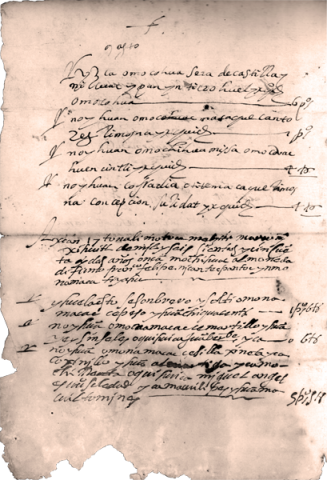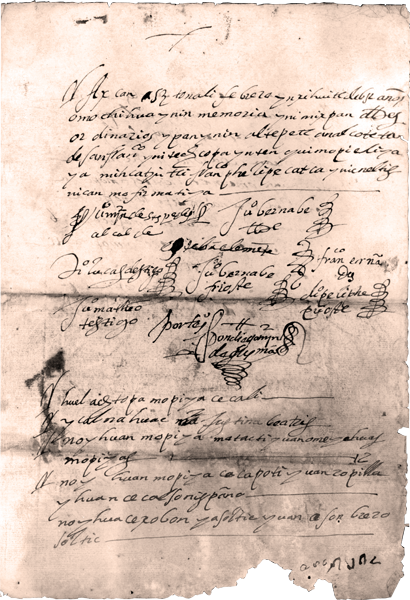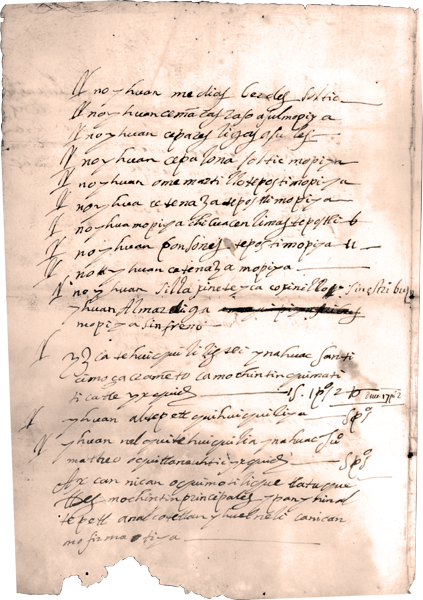This manuscript was first published in Beyond the Codices, eds. Arthur J.O. Anderson, Frances Berdan, and James Lockhart (Los Angeles: UCLA Latin American Center, 1976), Doc. 8, 78–83. However, the transcription, translation, and a new introduction presented here come from Lockhart's personal papers.
The original is found in the McAfee Collection, UCLA Research Library, Special Collections.
[Introduction by James Lockhart:]
To date Analcotitlan has not been located, but the text seems to belong with the considerable body of materials in the McAfee Collection that come from western Mexico, and its language has some of the characteristics of that region, as will be seen in more detail below.
Municipal and cofradía officials are in charge of the proceedings. In addition to making an inventory of the assets of Francisco Felipe, the steps taken include organizing and paying for funeral observances for him, but the emphasis and primary motivation have to do with collecting his debts to the cofradía and the altepetl. He was likely the mayordomo of the cofradía, which involved acting as treasurer, and he has ended up with a hefty debt to the organization.
The two outstanding features of Francisco Felipe’s property as listed are first, some fancy, up-to-date clothing in Spanish style (though much of it naturally showing signs of wear), and second, evidence of his being a horse breeder on quite a large scale. He owned no fewer than twelve brood mares and had an impressive set of farrier’s or blacksmith’s tools. On the other hand, we hear nothing of landholdings.
With the debt to the cofradía, the peso amount is given as “15 . 1,” with 2 reales in addition (line 30). Here the writer, although using Arabic numbers, is reckoning by the traditional Nahuatl system in which 16 is 15 + 1, caxtolli once. Thus the Spanish annotation in another hand, “deue 17 pos 2,” is a correction adding a peso to the total.
In many ways the language of the text is a quite normal Nahuatl, but there are numerous signs pointing to the western region, traits often shared with Doc. 27 from Jalostotitlan.
The preterits of verbs are different than in central Mexican Nahuatl, and in exactly the same way as in Doc. 27. The only preterits which are orthodox are the plurals, as well as the singulars of unreduced Class 1 verbs, thus “omonamacac,” “it was sold,” in line 59. All the singular preterits of Class 2 and 3 verbs are unorthodox by the standards of the center. Central Nahuatl Class 2 verbs drop the final vowel in the preterit; here they retain the final vowel and may or may not have a suffix. Thus mochihua, “it is done,” appears in the preterit as “omochihua” (line 49) and “omochihuac” (line 54), but not as omochiuh, the central form. The version with no suffix may be explained by the weakening of the final [k] in speech to the point where it was sometimes not perceived. The single example of a preterit Class 3 verb in the singular, “oquitlaneuhtic,” “he borrowed it” (lines 34–35), again varies from the central form, which would be oquitlaneuhti. The preterit loses the a of the present tense in both versions, but the form here has -c instead of the unwritten glottal stop of the center. To repeat, all these traits are equally illustrated in the document from Jalostotitlan.
Also as there, we see switching back and forth between t and tl, above all in the absolutive ending (“tepostli,” “metal,” line 23; “teposti,” line 25), but also elsewhere (for Analcotitlan, in line 3 “analcotetan,” in line 37 “analcotetlan”).
And again as in Jalostotitlan, the relational word -nahuac, “close to, next to,” is used more broadly than in central Mexican Nahuatl. Twice it appears in connection with owing money to someone, indicating the indirect object in a way it did not do in the center, as in “quitehuiquilia ynahuac Juo matheo,” “he owes it to Juan Mateo” (line 34). But the same expression also occurs in the central style, without -nahuac: “altepetl quihuiquiliya,” “he owes it to the altepetl” (l. 33).
Thus in several ways the document shows typical western language traits, but accompanied by signs of central Nahuatl influence of some kind as well.
The text was composed around the outset of Stage 3 as manifested in central Mexican Nahuatl, but even in the small sample here we see that Analcotitlan is keeping up with the center in language contact phenomena and orthography. Indeed, more generally one tends to find the peripheral areas up to date with or even moving more quickly than the central region. The most important orthographic innovation of Stage 3, the replacement of c/z by s, has become the norm here, though there are some exceptions and indeed one hypercorrection in the other direction, “çacrame¯to” with ç where there had already been an s.
No loan verbs occur in this brief text, but the loan particle sin, “without,” is seen twice (lines 27, 28). In “medias verdes” (line 18), “green hose,” “raso asul” (line 19), “blue satin,” and “ligas asules” (line 20), “blue garters,” we see Spanish adjectives as loanwords. The borrowing of adjectives was always rare and is associated mainly with Stage 3, but the color words began to come in somewhat earlier, and usually as here in direct connection with loan nouns, as though the two words were a single substantive expression.
The native verb huiquilia, which in central Mexico first came to mean to owe money in the second and third decades of the seventeenth century, is already standard in that meaning in the present text. In line 27 “yca,” standard ica, an instrumental relational word, is used as the equivalent of Spanish con, “with,” just as was happening in the center. The text also contains a plethora of loanwords for technical and rare items, but Nahuatl had already begun to do that far back in Stage 2.
Twice (lines 3, 37) the name of Analcotitlan is written with e instead of i (”analcotetan,” “analcotetlan”). However, replacement of i by e is not seen anywhere else in the text. [Note from Stephanie Wood: There was a corregimiento of Analcotetlan in the Tonalá region of the larger region of Guadalajara, Nueva Galicia.]
In lines 18 and 21 “soltic,” “used, old, worn,” has lost a syllable from standard içoltic, but in line 58 the first syllable returns in “isolti” (though the final c disappears).
In line 21, “palona” is from Spanish valona, a type of large soft collar, in line with the frequent substitution of p for Spanish b/v. Most loanwords in the text, however, are reasonably close in spelling to the Spanish originals.
In line 36, “tlatuque,” standard tlatoque, “rulers,” is used for the officers of the cabildo and other prominent men in the same fashion as it long had been in central Mexico.
In line 40 and elsewhere, don Diego Martín de Guzmán is the only person other than the notary who actually signed his own name. Also the title don and his noble surname raise him above anyone else mentioned, though the alcalde Céspedes has a very good-sounding surname too.
In line 42 the somewhat archaic native term amatlacuilo, “writer on paper,” is used instead of the loanword escribano for notary. The i of the first person prefix is not elided as it would be in the center: here “niamatlacuilo,” standard namatlacuilo.
In line 49, the standard form of “huencintli,” “offering,” is huentzintli. Perhaps here [ts] has been lenited to [s].
In lines 55–56, in “monamacatiyahu,” “-tiyahu” would standardly be written -tiyauh or tiauh and is the equivalent of -tiuh, the progressive auxiliary based on yauh, “to go,” so that the form means “it goes along being sold.”
----------
Este manuscrito fue publicado por primera vez en Beyond the Codices, (Más allá de los códices), eds. Arthur J. O. Anderson, Frances Berdan y James Lockhart (Los Ángeles: Centro Latinoamericano de UCLA, 1976), Doc. 8, 78-83. Sin embargo, la transcripción, traducción, y una nueva introducción se presenta aquí provienen de los documentos personales de Lockhart.
El manuscrito original se encuentra en la Colección de McAfee, Biblioteca de Investigación de la UCLA, Colecciones Especiales.
[Introducción por James Lockhart:]
Hasta la fecha Analcotitlan* no ha sido localizado, pero parece que el texto pertenece a la considerable cantidad de materiales en la Colección de McAfee que vienen desde el oeste de México, y su lenguaje tiene algunas de las características de esa región, como se verá con más detalle abajo.
Los funcionarios municipales y de cofradía están a cargo de los procedimientos. Además de hacer un inventario de los bienes de Francisco Felipe, las medidas adoptadas incluyen la organización y el pago de las practicas funerarias para él, pero el énfasis y la motivación principal tiene que ver con la recogida de sus deudas a la cofradía y el altépetl. Él era probable el mayordomo de la cofradía, que consistía en actuar como tesorero, y ha terminado con una deuda considerable a la organización.
Las dos características más destacadas de la propiedad de Francisco Felipe, tal y como aparecen en la lista, son en primer lugar, alguna ropa de lujo, ropa a la moda al estilo español (aunque gran parte de ella muestra signos de desgaste natural), y segundo, la evidencia que muestra que el criaba a los caballos a gran escala. Era dueño de no menos de doce yeguas de cría y tenía un impresionante conjunto de herramientas de herrero. Por otro lado, no sabemos nada de tenencia de tierras.
Con la deuda que debe a la cofradía, la cantidad en pesos se da como "15. 1", con 2 reales además (línea 30). Aquí el escritor, aunque use números arábigos, el cálculo de cuentas por el sistema tradicional náhuatl en la que 16 es 15 + 1, caxtolli una vez. Por lo tanto, la anotación española en otra mano, "deue 17 pos 2," es una corrección añadiendo un peso al total.
En muchos sentidos, el lenguaje del texto es un náhuatl bastante normal, pero hay numerosos indicios que señalan que viene de la región occidental, rasgos a menudo compartidos con el Doc. 27 de Jalostotitlán.
Los pretéritos de los verbos son diferentes en el náhuatl de México central, y en exactamente la misma manera que en el Doc. 27. Los únicos pretéritos que son ortodoxos son los plurales, así como los singulares de los verbos de clase 1 no reducidos, por lo tanto "omonamacac", "fue vendido" en la línea 59. Todos los pretéritos singulares de los verbos de la clase 2 y 3 no son ortodoxos por las normas del centro. Los verbos de la clase 2 del náhuatl central deja la vocal final en el pretérito; Aquí se conserva la vocal final y pueden o no tener un sufijo. Así, mochihua, "está hecho", aparece en el pretérito como "omochihua" (línea 49) y "omochihuac" (línea 54), pero no como omochiuh, la forma central. La versión, sin sufijo puede explicarse por el debilitamiento de la [k] final en el habla que hasta un punto a veces no se percibe. El único ejemplo de un verbo de clase 3 del pretérito en el singular, "oquitlaneuhtic", "tomó prestado" (líneas 34-35), de nuevo varía de la forma central, que sería oquitlaneuhti. El pretérito pierde la ‘a’ del tiempo presente en ambas versiones, pero la forma aquí tiene -c en lugar de la parada global no escrita del centro. Para repetir, todos estos rasgos se ilustran igualmente en el documento de Jalostotitlán.
También como allí, vemos una alternación entre t y tl, sobre todo en el final absoluto ("tepostli", "metal", línea 23; "teposti", línea 25), pero también en otros lugares (por Analcotitlan, en la línea 3 "analcotetan," en la línea 37 "analcotetlan" *).
Y de nuevo, como en Jalostotitlán, la palabra relacional -nahuac, "cerca de, junto a," se utiliza más ampliamente que en el náhuatl mexicano central. Dos veces aparece en relación al dinero que se le debe a alguien, indicando el objeto indirecto de una manera que no lo hizo en el centro, como en "quitehuiquilia ynahuac Juo Matheo", "le debe a Juan Mateo" (línea 34). Sin embargo, la misma expresión también ocurre en el estilo central, sin -nahuac: "quihuiquiliya altépetl", "se lo debe a la altépetl" (l 33.).
Así, en varios aspectos, el documento muestra los rasgos típicos de la lengua occidental, pero acompañado de signos de influencia del náhuatl central de algún tipo.
El texto fue compuesto alrededor del inicio de la etapa 3 como se manifiesta en el náhuatl central mexicano, pero incluso en la pequeña muestra que tenemos aquí vemos que Analcotitlan se está manteniendo al día con el centro en fenómenos de contacto de le lenguaje y ortografía. De hecho, más generalmente uno tiende a encontrar las áreas periféricas actualizadas o incluso moviéndose más rápido que la región central. La innovación ortográfica más importante de la etapa 3, la sustitución de c / z por s, se ha convertido en la norma aquí, aunque hay algunas excepciones y de hecho una hipercorrección en la otra dirección, "çacramēto" con ç donde ya había una s.
No hay verbos de préstamos en este breve texto, pero el artículo prestado "sin" aparece dos veces (líneas 27, 28). En "medias verdes" (línea 18), "la manguera verde", "raso asul" (línea 19), "satén azul," y "ligas asules" (línea 20), vemos adjetivos españoles como préstamos. El endeudamiento de los adjetivos siempre fue poco frecuente y se asocia principalmente con la etapa 3, pero las palabras de color comenzaron a entrar un poco antes, y por lo general como en este caso en conexión directa con los sustantivos de préstamo, como si las dos palabras eran una sola expresión sustantiva.
El verbo nativo huiquilia, que en el centro de México tenía como sentido ‘originario’ el sentido de ‘deber dinero’ en la segunda y tercera década del siglo XVII, ya es ese significado en el presente texto. En la línea 27 "yca," ica estándar, una palabra relacional instrumental, se utiliza como equivalente de la palabra "con” en español, tal como sucedía en el centro. El texto también contiene una gran cantidad de préstamos para artículos técnicos y raros, pero náhuatl ya había empezado a hacer eso mucho antes en la etapa 2.
Se escribe dos veces (líneas 3, 37) el nombre de Analcotitlan con ‘e’ en lugar de ‘i’ ("analcotetan", "analcotetlan"). * Sin embargo, la sustitución de la ‘i’ por ‘e’ no se ve en ninguna otra parte del texto.
En las líneas 18 y 21 "soltic", "utilizado, viejo, llevado," ha perdido una sílaba de içoltic estándar, pero en la línea 58 la primera sílaba regresa en "isolti" (aunque desaparece la c final).
En la línea 21, "palona" es de la palabra española, ‘valona’, un tipo de cuello grande y suave, en línea con la sustitución frecuente de p para español b / v. La mayoría de los préstamos en el texto, sin embargo, está razonablemente cerca en la ortografía a los originales españoles.
En la línea 36, "tlatuque," tlatoque estándar, "gobernantes", se utiliza para los oficiales del cabildo y otros hombres prominentes de la misma manera, como ya había estado en el centro de México.
En la línea 40 y en otros lugares, don Diego Martín de Guzmán es la única persona a parte del notario quien llego a firmar su propio nombre. También su título de don y su apellido noble le elevó por encima de cualquier otra persona mencionada, aunque el alcalde Céspedes también tiene un apellido de muy buena posición.
En la línea 42, algo arcaico el termino nativo “amatlacuilo", “escrito sobre el papel," se utiliza en lugar de escribano, la palabra prestada del español para notario. La ‘i’ de la primera persona prefijo no se elide, ya que sería en el centro: aquí "niamatlacuilo," namatlacuilo estándar.
En la línea 49, la forma estándar de "huencintli", "ofrenda", es huentzintli. Quizás aquí [ts] ha sido lenitivo a [s].
En las líneas 55-56, en "monamacatiyahu", "-tiyahu" de forma estándar se escribiría “tiauh” o “tiyauh” y es el equivalente de -tiuh, el auxiliar progresivo basado en yauh, "ir", por lo que la forma significa que "va vendiendo ".
*Nota de Stephanie Wood: Hubo una corrección de Analcotetlan (con esta ortografía, teniendo la ‘i’ sustituido con un ‘e’) en el área de Tonalá de la región más grande de Guadalajara, Nueva Galicia. Jalostotitlán no está muy lejos.
[Traducción al castellano por Melanie Hyers.]





